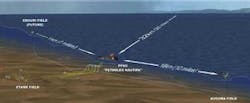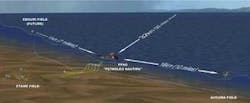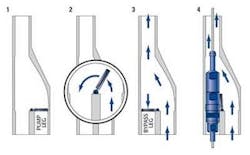Dual ESP completions solve West Africa deferred production
Christopher Gann, Formerly with VAALCO
Glenn Toney, Barry Nicholson - Schlumberger
West Africa’s first dual y-tool, dual electrical submersible pump (ESP) wells installed for VAALCO Energy Inc, are addressing the risks of deferred production and unplanned intervention due to lack of rigs. Driven by the desire to maximize return on investment, the company is determined to reduce the commercial and technical risk to acceptable levels to complete and produce the wells.
Offshore West Africa rigs are in short supply with availability estimates ranging from 6-months to a year and day rates continuing to rise. This complicates the scheduling of workovers and drives up their cost along with deferred production. Consequently, the shutdown of a well due to equipment failure is economically disastrous.
Early this year, the company began production from two oil producers in its Avouma satellite field, which lies about 10 miles (16 km) south of the Etame field offshore Gabon, West Africa. The wells produce to an unmanned platform and are tied back to the Etame floating production storage and offloading (FPSO) vessel,Petroleo Nautipa, by a subsea pipeline. Etame currently produces 14,000 boe/d of oil. A new discovery, Ebouri, near the northern boundary of the Etame Block, is also expected to be tied back to the FPSO in Q3, 2008, according to the company. The two Avouma wells together produce 7,200 boe/d of oil, and represent a significant portion of the company’s total production. Potential production from the two wells has been estimated at 10,000 to 12,000 boe/d of oil.
Investigating redundancy
The company launched an intense investigation aimed at assuring continuous, trouble-free production throughout the reservoir’s economic life. Driven by the desire to maximize return on investment, VAALCO was determined to reduce the commercial and technical risk to acceptable levels and selected Schlumberger as a service partner to complete and produce the wells. One of the most recent success stories for the dual ESP technique, the Avouma completion borrowed heavily from positive experiences recorded on more than 30 high-risk installations around the world.
The key feature characterizing the dual-ESP technique is the ability to switch from one pump to the other in a matter of minutes, and with minimal intervention. With a fully-redundant operational spare pump installed in the well, the operator is protected from even a completely-unexpected failure. Should a failure occur, the company could easily switch to the back-up pump and continue production unabated while it plans and mobilizes workover equipment, services, rigs, etc., thus minimizing the risk of deferred production?
But VAALCO was not satisfied to simply install a back-up. It wanted to take steps to ensure maximum efficient life from the pumps it had. The company set three goals: minimize the risk of deferred production for prolonged time intervals, provide real-time downhole data for production optimization and reservoir monitoring and provide ESP surveillance to eliminate preventable failures and provide an early-warning system. Compared to unexpected loss of production from Avouma; the added cost of the dual-ESP solution was valuable insurance.
null
Methodical risk reduction
The chosen pump configuration was the dual ESP bypass system that features an Auto Y-Tool subsurface automatic diverter system with an integral flapper valve. The flapper valve is actuated by flow and requires no mechanical intervention to shift it from pump to bypass mode. The dual y-tool allows reservoir access through the bypass tubing for conducting sandface measurements or remedial completion services without the need for an intervention.
A methodical approach was taken to ensure reliability and performance of the system:
- *The ESP system and completion were designed to maximize performance and minimize risk of installation and operation through the life of the field. The design included a completely instrumented downhole and surface system including independent multiphase flow meters on each well’s flow line. This provides accurate data on the pump, the production stream and the reservoir to be transmitted via satellite to a secure web-hosted surveillance system and allows well monitoring and analysis to be performed in real time.
- *An initial load flow study was performed to qualify the system capacity for increased loading. In addition, power factor, line and load harmonic analyses as well as short circuit and protective coordination were studied to ensure an optimized system. These upfront studies allowed accurate equipment sizing and enabled intelligent infrastructure choices on surface equipment, such as cable sizing, routing, required power distribution equipment and harmonic filtering.
- *Surface electrical connections were engineered and designed to allow for minimal human intervention to switch pumps. Both electrical connections were tied into a common junction box with contactor to allow for simple switching of the power supply from one pump to another. In addition, power sensing equipment provides a signal for the system to know which pump is running so pressure and temperature information can be accurately calibrated.
It should be noted that when dual ESPs are employed, it is traditional to run the lower ESP until it either fails or reaches incipient failure mode, then switch to the upper ESP. It is not considered good practice to alternate the pumps for any reason. The philosophy is that unnecessary ESP stops and starts could cause damaging electrical loading and shorten the motor’s service life.
Past experience contributes
Dual ESP completions have been run successfully in high-risk wells around the world.
Past experience played a major role in designing, installing and commissioning this completion. A thorough analysis was conducted of the well bore and completion requirements and compared with lessons learned on similar completions. A joint operator/contractor team evaluated other operators’ procedures and lessons learned. In addition, well site visits to witness ESP running activities and equipment make-ups with another operator proved valuable and led to the use of newly developed tools and techniques that further improved reliability. One such modification improved the way the packer penetrator system worked and how it was assembled. This led to time savings during the installation and is expected to yield better reliability.
Enhanced quality program
In addition, an enhanced quality program (EQP) assured 100% inspection of all critical parts as well as tightening of manufacturing tolerances. This type of stringent quality assurance plan has proven to reduce the risk of unexpected events and also contributes to prolonged equipment life. The EQP was only the beginning. The equipment then had to pass full load tests, again with tightened tolerances, to assure that the system had the best chance of operational success.
As part of the EQP, a power system analysis was conducted to determine how the equipment would operate at different loads. The study involved the use of a computer model to simulate various platform power loads, motor starting, and harmonic analysis. This work proved extremely useful and indicated that harmonic heating could be reduced and additional power and life could be attained if the supply-side harmonics were reduced. In addition, the power quality downstream of the variable speed drive (VSD) was modeled. This step indicated that the harmonics created by the VSD could potentially cause voltage overshoots at a specific frequency and these voltage overshoots could be at least 2.5 times the output voltage, exceeding the electrical insulation rating as well as weakening other system components, potentially causing a failure. Accordingly, it was decided to address the issue with a VSD with a 12-pulse cancellation front end that incorporated an output sine wave filter. This solution would mitigate the harmonics on the generator as well as the harmonics and voltage overshoots entering the ESP system.
Testing the theories
This is good on paper but what happens when the system is actually installed in the well? In the past, it has been proved that besides an EQP, performing a stringent factory acceptance test (FAT) and system integration test (SIT) has been instrumental in minimizing or eliminating risk of premature failure and in identifying potential complications. A complete full load string test was conducted at the manufacturing center to assure proper assembly and operation of all ESP components as a complete unit. All measurements were recorded during assembly to assure proper fit in the field. A thorough SIT ensures that all completion components go together properly before being installed in the well. The SIT was performed, and all of the pieces went together except for a few minor areas found to need improvement. These were rectified before the installation, potentially saving rig installation time and eliminating failure points.
Although the cost measured in time and money, to conduct the due diligence, additional quality plans and testing is not insignificant, it was considered a small price to pay to reduce risk of premature equipment failure and the high cost of deferred production.
Sharing the risk
A performance-based contract was conceived to identify key performance indicators (KPI), and aligned the objectives according to the project’s ultimate success. This ensured that all parties shared strong incentives to work toward the common goal.
Since a key driver was maximum uptime and production, the completion was equipped a monitoring and surveillance system with associated telemetry to monitor pump and well performance and allow 24/7 remote surveillance and control. With this system collaboration between ESP experts, reservoir engineers and surface operators could identify production, artificial lift, or surface abnormalities and make appropriate adjustments. This means that the pumps could be fine-tuned to optimize production as well as their own efficient operation. Life-cycle modeling was employed in the design to accommodate future anticipated production parameters.
Throughout the design and commissioning phase, VAALCO engineers took the position that most ESP failures are preventable; therefore, they set out to anticipate and prevent them by a combination of good engineering practice, choosing proven reliable equipment, redundancy and thorough testing. They projected this work ethic through the operation phase by employing a continuous surveillance and monitoring system to ensure that the wells and the pumps would perform optimally with a long life.
To date, the dual ESP pumps with the dual Auto Y-Tools subsurface automatic diverter system have been successfully installed for 11 months.



